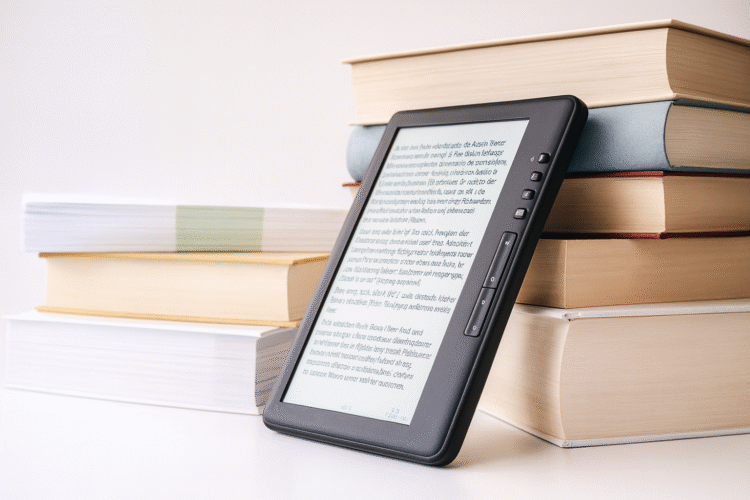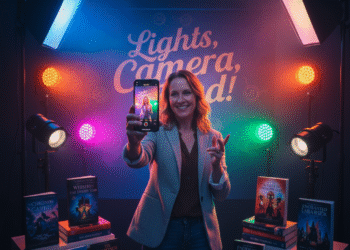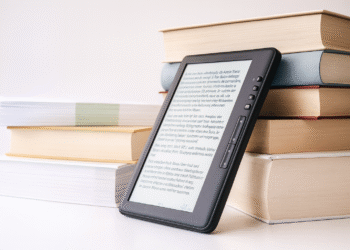If you’ve ever wondered why your mind sinks deeper into a printed book than an e-reader—or why your Kindle helps you fly through certain genres—then you already understand why paper vs. screen reading remains one of the most fascinating debates among bookworms today. And as new research continues to emerge, it’s becoming clear that the difference between reading on the page and reading on a screen is more complex, psychological, and emotionally layered than we once thought.
This blog explores what the latest science says about focus, retention, comprehension, emotion, and even sustainability, all through the lens of one big question:
📚 Does the format we choose change the way we experience a story?
Let’s dive deep into everything researchers—and readers themselves—are discovering about paper vs. screen reading, and what it means for the future of reading.
Why Paper vs. Screen Reading Matters More Than Ever
Although digital reading has exploded in popularity over the last 15 years, print books stubbornly continue to dominate. In fact, according to Statista, over 75% of global book revenue still comes from print, even as eBook adoption grows steadily each year.
But this isn’t just about market share. The rise of digital reading has changed everything from the way we browse bookstores to the way we annotate, focus, skim, remember, and even emotionally react to what we read.
And as our earlier WriteStats deep dive on reading-app data collection showed, digital reading comes with its own set of powerful advantages and unique concerns.
👉 https://writestats.com/what-data-do-reading-apps-collect-a-deep-dive-into-how-data-tracks-our-literary-habits/
At the same time, our research into sustainable book publishing shows that both paper and digital mediums carry very different environmental footprints.
👉 https://writestats.com/sustainable-book-publishing-7-practices-to-go-carbon-neutral/
So when we talk about paper vs. screen reading, we’re not just comparing personal preferences, we’re comparing entirely different reading ecosystems, each shaped by technology, psychology, design, and emotion.
Paper vs. Screen Reading: Focus and Attention
Why Paper Improves Focus in Most Studies
One of the most consistent findings in paper vs. screen reading research is that paper improves sustained attention. Across dozens of studies, readers on paper display:
- Fewer task-switching impulses
- Fewer distractions
- Deeper concentration
- Less “skimming behavior”
- Greater reading endurance
A major meta-analysis published in Educational Research Review found that reading on screens is strongly associated with reduced attention and increased cognitive load.
Why?
Paper is a single-purpose medium.
Your book cannot:
- ping
- buzz
- notify
- pop up
- refresh
- pull you into other apps
Even when notifications are off, the association remains. When you hold a phone, your brain anticipates multitasking. When you hold a book, it anticipates immersion.
This environmental difference is impossible for our brains to ignore.
Digital Reading Can Still Support Focus, With Conditions
Surprisingly, some studies note that digital readers can achieve focus equal to paper readers when:
- Notifications are off
- The device is distraction-free (e.g., eInk Kindle)
- The reading environment is quiet
- The content is narrative (not academic)
- The reader is already accustomed to digital reading
Meaning:
📱 A Kindle is closer to a paperback than an iPhone is.
A 2017 study in Applied Cognitive Psychology found that readers on eInk displayed nearly identical attention patterns to paper readers during fiction reading.
This shows that the type of screen matters just as much as the content.
Paper vs. Screen Reading: Memory Retention & Comprehension
Paper Offers Better Long-Term Memory for Most Readers
If you’ve ever finished a Kindle book only to forget half the plot the next day, you’re not imagining it. One of the strongest findings across literacy research is that paper improves memory retention.
A well-cited study from the International Journal of Educational Research showed that readers of print consistently outperform digital readers in:
- Recalling sequence of events
- Remembering details
- Understanding subtext
- Summarizing content
Why does memory differ so much?
1. Spatial Mapping
Paper books offer fixed, 3D locations:
- “top left of the page”
- “middle of the chapter”
- “last paragraph before the break”
This creates a mental map, making it easier for the brain to store and recover information.
Screens remove this physical anchor.
2. Screen Skimming
A 2018 study found that digital readers engage in more:
- skimming
- scanning
- scrolling
- selective reading
Even when we think we’re reading deeply, our scrolling rhythm contradicts us.
Digital Reading Can Match Print, for Fiction
But here’s something important for bookworms:
When it comes to fiction, comprehension gaps shrink dramatically.
The 2020 Delgado meta-analysis (171,000 participants) found that comprehension differences between paper vs. screen reading are much smaller for:
- romance
- YA
- thrillers
- fantasy
- contemporary fiction
Because fiction relies on emotional immersion more than technical details, the medium affects memory less.
So:
📚 Print = deeper recall
📱 Screens = faster consumption
Both have value.
Paper vs. Screen Reading: Emotional Engagement
Emotional engagement—how deeply a book affects us—is where things get truly fascinating.
Print Books Create Stronger Emotional Memory
Several fMRI studies (e.g., Dartmouth College, 2021) show that reading on paper activates the brain’s default mode network, responsible for:
- Empathy
- Sensory imagination
- Emotional simulation
- Internal visualization
In other words, paper helps your brain “live inside the story.”
Paper also:
- Creates fewer emotional interruptions
- Supports deeper mood immersion
- Gives emotion physical weight (literally!)
- Enhances sensory associations
Which helps explain why many readers say:
“I remember physical books more vividly than ebooks.”
But Screens Boost Certain Emotional Experiences
Interestingly, screens do enhance emotional engagement, but in different ways.
Digital readers tend to feel:
- Stronger emotional reactions to cliffhangers
- Heightened tension in thrillers
- Faster romantic attachment in rom-coms
- More excitement with rapid pacing
Because digital reading is faster and more immediate, emotional spikes feel more intense, even if emotional depth is sometimes lower.
Put simply:
🧠 Paper = slow-burn emotional resonance
💥 Screens = fast-burn emotional intensity
Both enrich reading life differently.
Paper vs. Screen Reading: The Role of Ritual and Sensory Experience
Bookworms know this instinctively:
Reading is not just cognitive.
It is sensory. It is ritual. It is emotional atmosphere.
Paper Reading Rituals Feel More Immersive
Think about:
- Curling up in bed with a paperback
- Holding the weight of a book
- Hearing the pages whisper
- The smell of ink and paper
- Seeing your progress physically
These sensory cues prime the brain for immersion and relaxation.
Screen Reading Rituals Support Flexibility
Digital reading invites:
- Guick sessions
- Reading while traveling
- Reading in low light
- Switching between books
- Carrying an entire library everywhere
These cues prime the brain for convenience, speed, and adaptation.
Different rituals create different emotional states, and they influence how we connect to stories.
Paper vs. Screen Reading: Environmental Impact
Bookworms increasingly care about sustainability, which makes medium choice even more complicated.
We explored this extensively in our WriteStats report:
👉 Sustainable Book Publishing: 7 Practices to Go Carbon Neutral
Print Books
✔ Biodegradable ✔ Durable ✔ Shareable ✔ Collectible
✘ Require trees ✘ Require water + ink ✘ Carbon-heavy manufacturing
✘ Significant shipping emissions
E-Readers
✔ Save paper ✔ Reduce shipping emissions ✔ Store hundreds of books
✘ Require rare earth metals ✘ Carry manufacturing pollution ✘ Become e-waste if not recycled
A University of Michigan lifecycle report found that an e-reader becomes more eco-efficient after 30–100 books, depending on reading habits.
So the more you read, the greener digital becomes.
Paper vs. Screen Reading: Privacy, Data, and Digital Footprints
In print reading, your thoughts stay private.
In digital reading, your habits become data.
Our WriteStats investigation into reading-app data collection uncovered how apps track:
- Reading speed
- Highlighting patterns
- Emotional keywords
- Chapters most often abandoned
- Reread frequency
- Time of day
- Device location
This affects:
- Personalization
- Recommendations
- Retailer targeting
- Author discoverability
- Reader autonomy
So paper vs. screen reading isn’t just a cognitive question, it’s a privacy question.
So… Which One Is Better? The Final Verdict for Bookworms
After reviewing dozens of studies across attention, comprehension, retention, emotional engagement, and environmental impact, one thing is clear:
📚 Paper and screens are not opposites.
They are complements.
Choose paper when you want:
- Immersion
- Calm
- Memory retention
- Emotional depth
- Fewer distractions
- Rich sensory experience
Choose screens when you want:
- Flexibility
- Speed
- Convenience
- Adjustable fonts
- Portability
- Sustainability after enough use
Most bookworms benefit from both.
How You Can Use Both Formats to Enrich Your Reading Life
Read immersive, emotional books on paper
Fantasy, literary fiction, classics, slow-burn romance.
Read fast-paced genres on digital
Rom-coms, thrillers, YA, novellas, serial fiction.
Use your e-reader for travel + nighttime reading
Convenience matters.
Build print collections for books you emotionally treasure
Your favorites deserve “forever homes.”
Mix mediums depending on mood
Your reading experience will become richer and more varied.
Final Thoughts
The paper vs. screen reading debate isn’t about choosing sides. It’s about recognizing that each format shapes your reading mind in beautifully different ways. Paper invites deep, sensory immersion. Screens invite speed, flexibility, and accessibility. And as bookworms, we’re lucky to live in a reading era where we don’t have to choose.
Whether you love the glow of your Kindle at midnight or the weight of a hardcover on a lazy Sunday morning, both choices enrich the way you explore stories.









